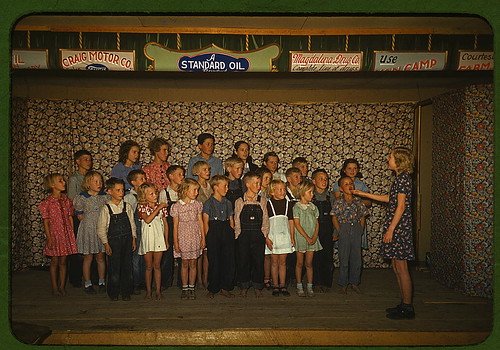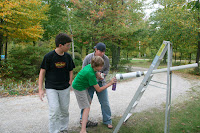Mileva introduced us to Origami USA, a national society devoted to origami. Although I originally contacted them to get bulk rates on origami paper—necessary when your kids are going through stacks of the stuff—I also appreciated the informational resources and sense of community they fostered. Discovering fellow enthusiasts was part of the fun. While we were studying the diagrams and feeling mystified by the instructions (often written in Japanese), we thought about our relatives in Japan and the Japanese friends we had made through the Labo International Exchange Program.
I have fond memories of a wonderful, sunny afternoon spent in the company of an elderly woman at an event hosted by the Japanese American Citizens League (JACL). The unassuming woman sat at a table and quietly demonstrated fold-after-fold to a steady stream of visitors. Young and old learned how to create beautiful stellated octahedrons (12 pieces of paper; pictured right) and icosahedrons (30 pieces of paper). These projects, which seemed impossible to us at first, quickly grew into a habit-forming routine—all thanks to this lovely demonstrator. We filled our house with polyhedrons.
I'm sure Mileva, a brilliant woman with an aptitude for mathematics, used various origami lessons to teach her children about geometry. Rectangles, triangles, parallel lines, right angles—it was all there, somewhere, in the art of paper folding. While her explanations of math through origami might not have impressed someone like Robert Lang (TED Talk: "The Math and Magic of Origami;" website: Origami Mathematics), her creativity and enthusiasm inspired many fans. My kids and I were among them.
Unlike Mileva, I didn't use origami explicitly for math instruction. However, I suspect origami nurtured my kids' natural interest in patterns and connections: if they could take a two-dimensional sheet of paper and turn it into a three-dimensional object, what else might be possible? Origami fostered their ability to visualize a shift from 2D to 3D, which in turn seemed to ease their later studies of molecular structures, fractals, and chaotic systems. Skills such as tenacity and attention to detail—essential for success at origami—also happened to be quite useful for math—and life.
There are many things worth doing, but we can't always see the value in advance. Sometimes, we have to trust what feels right, give in to our creative impulses, and avoid worrying excessively about outcomes or assessments.
Origami Resources
Interested in learning origami? Check out Origami Spirit (includes YouTube tutorials) by Leyla Torres. She recently posted "Twelve Lists of Top-Notch Origami Video Tutorials." Her videos range from simple to complex, and her enthusiasm for origami is contagious.
For anyone who would like to learn how to fold a simple, modular origami "ball," I found these helpful instructions by TheZocar on YouTube:



























